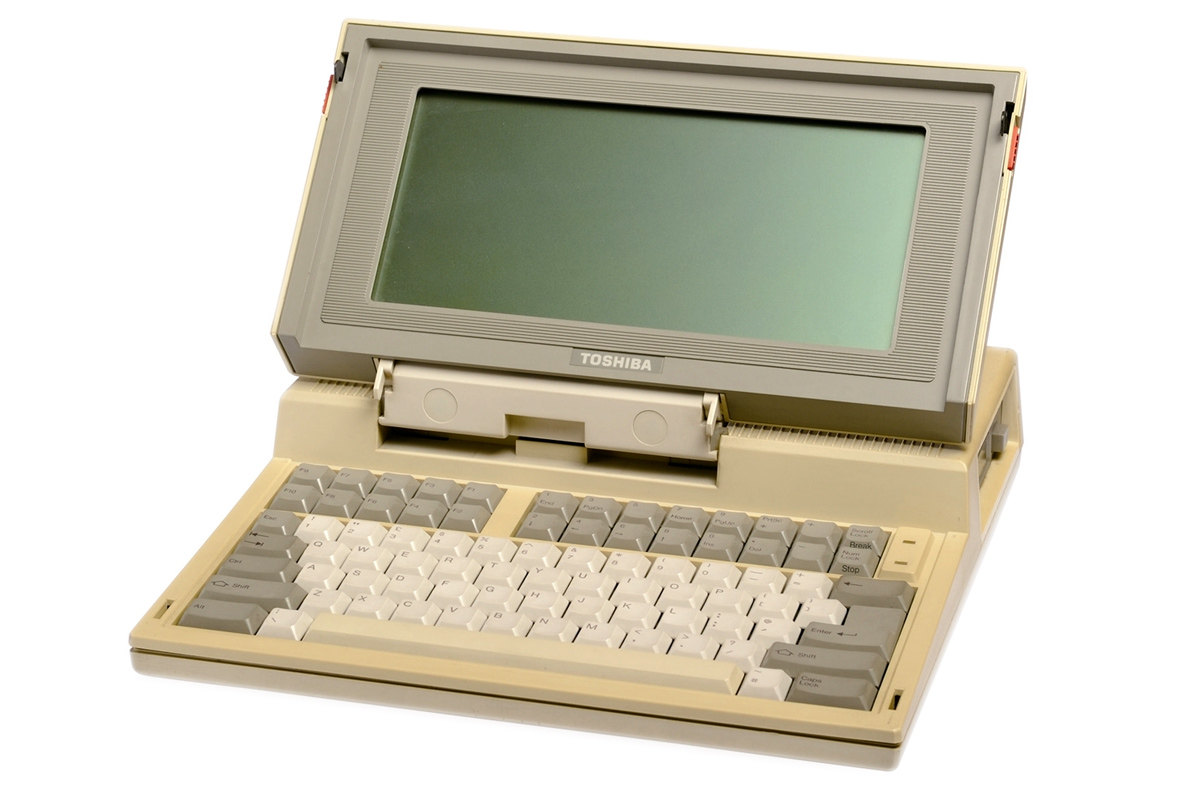Toshiba T1100
Introduction
 Toshiba launched their first laptop computer in 1985 with their T1100. This was essentially an IBM PC cleverly compressed down to a size of 12.2" x 12" x 2.6". It ran the same Intel 8088 CPU at 4.77 MHz, had a built-in 3.5" 720 KB floppy disk drive, 256 KB of RAM and ran a flavour of MS-DOS 2.11 co-developed by Toshiba and Microsoft, who were also responsible for developing the BIOS.
Toshiba launched their first laptop computer in 1985 with their T1100. This was essentially an IBM PC cleverly compressed down to a size of 12.2" x 12" x 2.6". It ran the same Intel 8088 CPU at 4.77 MHz, had a built-in 3.5" 720 KB floppy disk drive, 256 KB of RAM and ran a flavour of MS-DOS 2.11 co-developed by Toshiba and Microsoft, who were also responsible for developing the BIOS.
Its built-in monochrome "twisted nematic" LCD screen was able to display CGA graphics up to 640 x 200 resolution as well as full 80 x 25 text mode. You could also connect it to an RGB monitor.
Memory could be expanded to 512 KB via an optional plug-in card.
In 1985, this was no small feat. Toshiba made use of LSI (Large Scale Integration) technology to reduce the number of components on the mainboard as possible, and this would set the stage for a multi-billion dollar industry that based their designs on many of the concepts introduced with the T1100. Such things as built-in rechargeable batteries, tilt-up LCD display, 3.5" floppy drive, and of course, being compatible with an IBM PC.
Portable computing was nothing new in 1985. Before Toshiba's T1100 clamshell design came luggables from Osborne, Tandy Radio Shack, and Seiko Epson. Back in 1983, Toshiba sent three employees to Los Angeles for two months to plan Toshiba's re-entry in the PC market after their initial failed attempt with a desktop computer a year earlier. That failed because it wasn't IBM-compatible. They came back with the firm belief that another desktop PC was not the answer. Mobile computing was in demand; Toshiba's project leader, Atsutoshi Nishida said ""Our plan was for a clamshell-type transportable PC with an LCD and IBM compatibility".
They took their design proposal back to Toshiba's senior management, but they didn't believe such a computer would be accepted under the Toshiba brand name, so Nishida offered it to other companies to sell under their own brands. They all declined. In the end, Toshiba agreed but only after Nishida promised he could sell 10,000 units in the first year. The task of building the T1100 was going to be expensive, and Toshiba's engineering department would not pay for it, so Nishida committed funds from his international sales and marketing budget according to Nobuyuki Tanaka, who was one of 10 engineers that worked on the T1100 project.
Tanaka's team began work on the T1100 in April 1984 and had a prototype finished by August of the same year. Prior to commercialization, the project faced another hurdle. Toshiba's experience with desktop PCs had taught it that nobody would buy a PC without software and while the T1100 was to be IBM compatible, it was based on 3.5" floppy disks. At that time, the industry was standardized around 5.25" disks and there was no software available on the smaller format. "With no software it could run, our product would be just a box," Nishida said.
Nishida visited Lotus Development Corp, but was refused a request to put Lotus 1-2-3 onto 3.5" floppy disk. After numerous revisits, they relented. His next trip was to Ashton-Tate, maker of dBase II. They accepted, partly on the basis that Nishida had already won over Lotus. This was at a time when IBM-compatibility didn't always mean an assurance that all software would work. A major headache for Toshiba was trying to get Microsoft's Flight Simulator to run on the new machine - to many this was considered the ultimate test of compatibility.
The T1100 was launched in Germany in April 1985, then later that year at Comdex in the U.S.
Optional Peripherals
- PC1-PA7437E PC Floppy Link
- PC1-PA7224E External 5.25" 360KB FDD
- PC1-PA7235E External 3.5" 720KB FDD
- PC1-PA7435U 300 bps Bell 103 compatible modem/clock/RS-232-C card